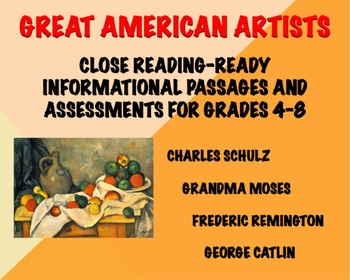Great American Artists: Reading Comprehension Passages and Assessments
- PDF
Description
This is the Great American Artists Collection. The United States of America has produced some great art works and very talented artists in the last 200 years, and this bundle of historical/biographical passages and assessments will help you teach your students about the lives and artwork of four very different but exceptional American artists: Grandma Moses, Charles Schulz, Frederic Remington, and George Catlin.
These Common Core-aligned biographical passages can be used in Grades 4-8 ELA, history, or art classrooms. Depending on your students' ability levels, they can be used for direct instruction in class, close reading, independent practice, homework, test prep, assessment, or even in centers.
Please note that no Peanuts comic strips or other copyrighted artwork/images of Charles Schulz are included in this collection. In your own classroom and while teaching a lesson you can project and explore copyrighted examples under the principle of “fair use.”
The collection includes:
An 850-word biographical passage on Anna Mary Robertson Moses (1860-1961), a farmer’s wife and mother of ten who lived a quiet, ordinary life until she discovered a passion for folk art and painting in her late 70s. Grandma Moses went on to become one of the most highly sought after and renowned painters in the world by her death at age 101. Flesch Kincaid Reading Level = 4.0
A 750-word biographical passage that tells the story of the great American cartoonist Charles Schulz (1922-2000). The article discusses his renowned Peanuts comic strip and explains how Schulz touched people and made a lasting mark on society that lasts to this day. Flesch Kincaid Reading Level = 5.1
A 900-word biographical passage on Frederic Remington (1860-1908), the most famous and prolific painter and sculptor of the Old West. Remington’s work is recognized as the definitive record of life in the early days of the American West and is sought after and known the world round. Flesch Kincaid Reading Level = 6.8
A 750-word historical passage on George Catlin (1796-1872), a painter who traveled to the unexplored West in the 1830s to create beautiful, colorful, and true-to-life paintings of the Native Americans before they had lost their freedom and traditional ways. Flesch Kincaid Reading Level = 5.5
Each passage concludes with a set of between 15-25 questions, all requiring careful reading and close re-reading of the text to answer. The assessments used align with these Common Core Informational Text Standards:RI.3.1, RI.4.1, RI.4.5, RI.5.2, RI.5.3, RI.5.8, RI.6.1, RI.6.3, RI.6.4, RI.6.7, and RI.6.8.
3) Answers are provided for every question. For the written questions a clear explanation is given to guide your discussion of students’ work.
This item is bound by copyright laws and redistributing, editing, selling, or posting this item (or any part thereof) on the Internet are all strictly prohibited without first gaining permission from the author. Violations are subject to the penalties of the Digital Millennium Copyright Act.
Any claims of correlation or alignment to the Common Core State Standards are solely those of Mark Aaron and have not been evaluated or endorsed by the NGA. Mark Aaron is the sole creator of this product and does not claim endorsement or association with the creators of the CCSS.





